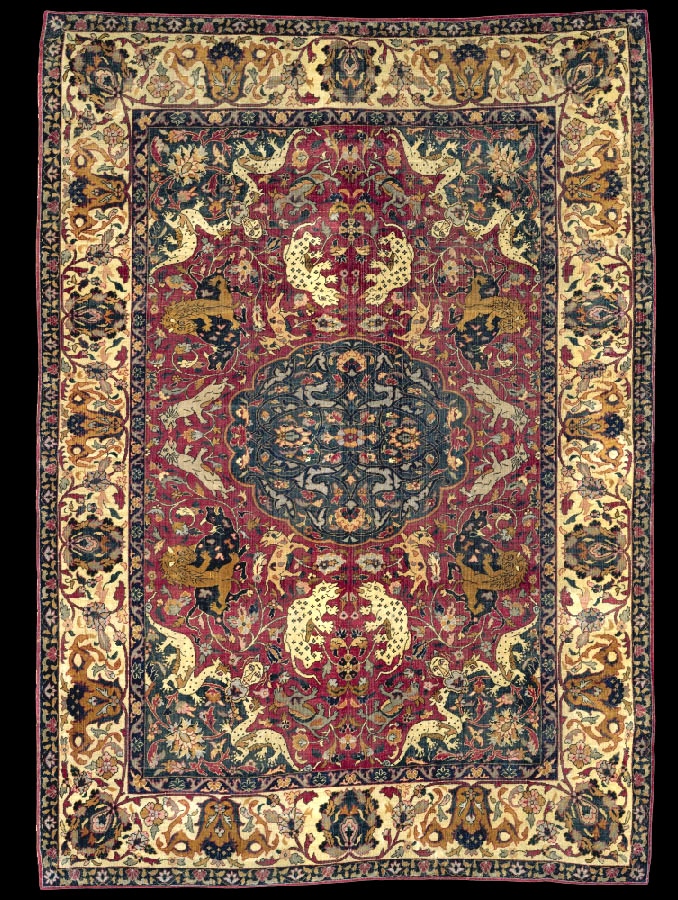|
Arts of The Islamic World
Sotheby's
Sale: L10220 | Location: London
Auction Dates: Session 1: Wed, 14 Apr 10 10:00 AM
LOT 357
A SAFAVID HUNTING RUG, EAST IRAN
late 16th/early 17th century
150,000—200,000 GBP
Lot Sold. Hammer Price with Buyer's Premium: 217,250 GBP
measurements: approximately 213 by 152cm., 7ft. by 5ft.
Description: late 16th/early 17th century
CATALOGUE NOTE
This rug is, unusually, one of a pair; its companion piece is in a North
American private collection. For a comparative pair of medallion hunting
rugs, late 16th century, incorporating animals and birds, but with the
addition of figures, please see Dimand, M. and Mailey, J., Oriental Rugs in
the Metropolitan Museum of Art, New York, 1973, the first known as
The Caponi Hunting Rug, 254 by 178cm, (Inv. no. 17.120.127); and the other
The Cochran
Hunting Rug, 251 by 171 cm, (Inv. no. 08.100, pp. 99–101, nos 9a,
9b, and p. 138, fig. 71).
For discussion and illustration of specifically comparable pieces see
Bennett, Ian, 'Splendours in the City of Silk, part 2: Ten Safavid
Masterpieces', in Hali, 33, pp. 38–49, with additional captions by Kurt
Erdmann, 1987, and of particular interest two late 16th/early 17th century,
Tabriz medallion Hunting Carpets from the Musée Historique des Tissus,
Lyon., pp.42-42, Pl.III and IV (Inv.no.23.921 and Inv.no.24.573), the latter
with similarities to the present carpet in having no animals or birds in the
outer border which has a light coloured ground, a red field, dark ground
spandrels.
For comparable layout and iconography, see examples in the
Thyssen-Bornemisza Collection, Lugano, including the
Béhague-Sanguszko
Carpet, late 16th century, with red border ground, and light field ground,
and similarly reduced central strapwork medallion, and the Béarn Hunting
Carpet, second half 17th century, with red ground to main field and border,
both illustrated in The Thyssen-Bornemisza Collection, Carpets and Textiles,
Friedrich Spuhler, Philip Wilson, London, 1998. pp.80-83, no.15., and
pp.96-99, no.19. respectively.
In addition to the identifiable animals in the composition of the offered
carpet, the spandrels have conforming stylised dragons clasping a shield
surmounted by an animal mask. Different versions of animal mask motifs
against a tendril covered ground, incorporating a dragon head clasping a
tendril, appear in the border of the Vaq Vaq,carpet fragment (32 by 79 cm.)
in The National Museum, illustrated in Pope, Arthur Upham, The National
Museum of Stockholm, 1938–39, pl. 1212B, 16th century, Persia or possibly
Indian. Dragons, of which a stylised version is incorporated as confronting
pairs in the spandrels of the present carpet, are rare in Persian carpets. A
distinct interpretation of a dragon appears in the border of a Medallion and
Animal Carpet, Persian, Kirman (?), 17th century, from The Joseph Lees
Williams Memorial Collection (Inv. no. 55-65-26), illustrated in Ellis,
Charles Grant, Oriental Carpets, Philadelphia Museum of Art, The Herbert
Press, London, 1988, No. 48, pp.160-167. Distinct animal masks appear in the
centre of foliate motifs in the border of the Peytel small silk carpet,
composed with animals interspersed with plants on a blue ground, from the
Musée du Louvre, Paris (Inv.6741), No.5, pl.3, illustrated Exhibition
Catalogue, Sheffield, Mappin Art Gallery, 10 April to 19 May 1976, Carpets
of Central Persia, May H. Beattie, World of Islam Festival Publishing Co,
1976. For an additional comparative Hunting Carpet, late 16th/early 17th
century, (with a light coloured border, dark ground spandrels, and a red
main field), with large blossoms and unusual detail of central masks, see
Wearden, Jennifer, Oriental Carpets and their structure, Highlights from the
V&A Collection, V&A Publications, London, 2003, pg. 26. pl.28, (Inv. no.
23-1883), and pls.25-27, for other hunting fragments.
Technical Analysis:
Warp: Silk, natural dark ivory, 2 strands, Z spun
Weft: Silk, natural dark golden, 2 shoots, each of three strands
Knotting: Wool, asymmetric open to the left, Z-spun, 2 strands, Sw plied,
ivory, ochre, pale blue, midnight blue, light grey, light rose madder,
crimson, dark forest green ,dark jade green
Sidecords: not original
Density: 6 V/6-7 H per cm. |
 |

